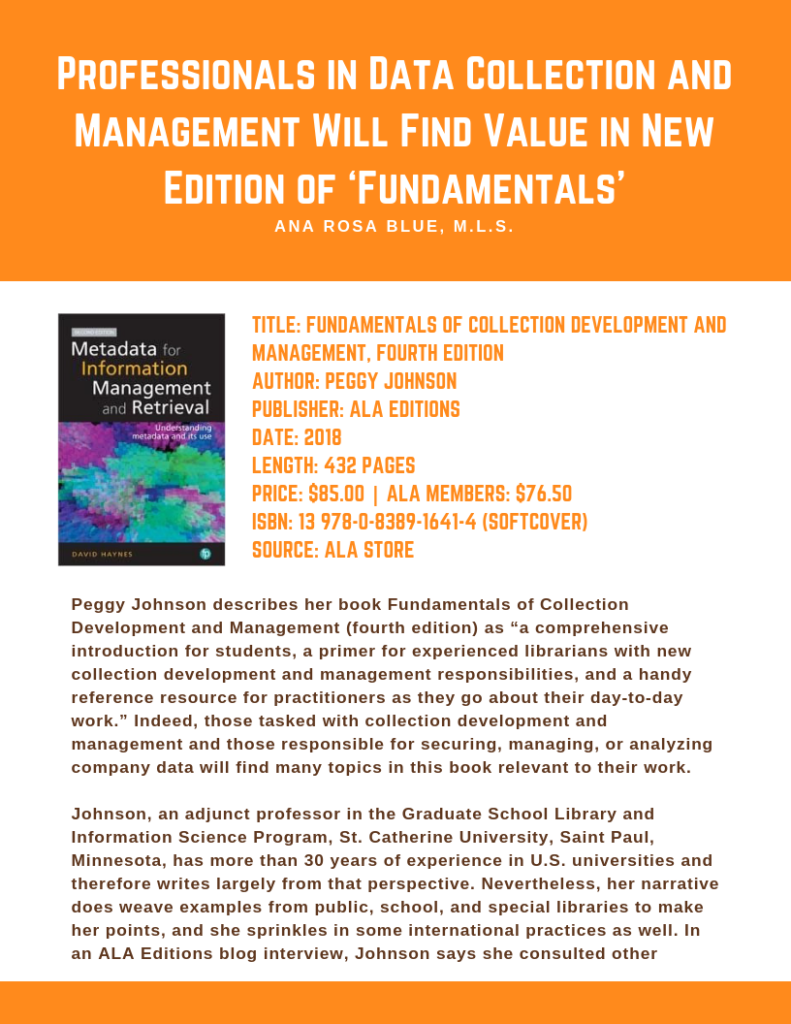Professionals in Data Collection and Management Will Find Value in New Edition of ‘Fundamentals’

Reviewed by Ana Rosa Blue
TITLE: Fundamentals of Collection Development and Management, Fourth Edition
Author: Peggy Johnson
Publisher: ALA Editions
Date: 2018
Length: 432 pages
Price: $85.00 | ALA Members: $76.50
ISBN: 13 978-0-8389-1641-4 (softcover)
Source: ALA Store
Peggy Johnson describes her book Fundamentals of Collection Development and Management (fourth edition) as “a comprehensive introduction for students, a primer for experienced librarians with new collection development and management responsibilities, and a handy reference resource for practitioners as they go about their day-to-day work.” Indeed, those tasked with collection development and management and those responsible for securing, managing, or analyzing company data will find many topics in this book relevant to their work.
Johnson, an adjunct professor in the Graduate School Library and Information Science Program, St. Catherine University, Saint Paul, Minnesota, has more than 30 years of experience in U.S. universities and therefore writes largely from that perspective. Nevertheless, her narrative does weave examples from public, school, and special libraries to make her points, and she sprinkles in some international practices as well. In an ALA Editions blog interview, Johnson says she consulted other librarians in preparation for this edition. The result is a thoroughly researched book that encompasses building and managing library collections regardless of format, genre, or origin.
The author begins with a history of how collection development and management evolved as a specialty within the profession in public, academic, and special libraries. She writes that librarians who provide the highest quality materials to users are “arbiters of quality,” a description this reviewer believes could apply to “all information professionals” as well. Johnson’s book will resonate with information professionals in other settings because she has an appreciation for the significance of managing legacy print collections. If your organization has a combined library, archives and/or records center, this book will be useful.
The notion of amalgamating libraries with archives is not new. For example, according to Dr. Guy Berthiaume, librarian and archivist of Canada, in 2004 Canada was one of the first countries to combine its national library and national archives. Glenstone, in Maryland, has integrated its library, archives, and museum collections into one information management system. More recently, “50 Things You Can Do” to support collections as data was published, by the Andrew W. Mellon Foundation. Any one of those 50 “things” could apply beyond a library setting. There is no doubt that collections and acquisitions managers are dealing with similar issues, regardless of what the collection is or how it was obtained.
Acquisitions/collections professionals have a wide breadth of responsibilities in addition to the selection and acquisition of materials. For example, collections are searchable through finding aids or cataloguing. Further, managing and maintaining a collection is as important as its development. In her book, Johnson addresses issues of weeding, storage, and preservation. For example, she asks if you are weeding for withdrawal or for transfer to storage or elsewhere?
Additionally relevant to any information professional is the book’s discussion of ways to protect your collection from deterioration, theft, mutilation, and disaster. Information professionals will also find value in her discussions of these topics: budgets; ethics; security; selecting access methods for digital resources; ways to identify and solicit materials for inclusion in a digital repository; preservation reformatting and copyright law; mass digitization; preservation plans and collection protection; and marketing and research.
The discussion on vendor relations, negotiations, and contracts is particularly interesting. Johnson has said that “vendors are trained in selling and promoting their products and especially in negotiating effectively.” She maintains that it is equally important for information professionals to acquire parallel skills.
Johnson’s book will be best used as a reference tool. Every chapter contains new suggested readings and fictional case studies to stimulate discussion. Readers are directed to previous reading lists and case studies. The glossary and appendices have been updated and all URLs were valid as of fall 2017. This inevitably means that recent information will not appear in the print edition. Notably, her third edition has been on the curriculum for collection development courses at Indiana University and the University of British Columbia.
Johnson’s new edition is ideal for those starting out in information studies and for seasoned professionals alike. It provides a solid foundation and support to those who bring a wealth of knowledge, skills, and abilities to their collection development and management tasks. You are an “arbiter of quality” if you are responsible for collections at your institutions, and you will benefit from this book accordingly.

Download the PDF version of the article.
[ls_content_block id=”896″]
[ls_content_block id=”430″]
About the Author

- Ana Rosa Blue, M.L.S., has a Master of Library Science degree from the University of British Columbia and a Records Management Practice Certificate from the University of Toronto. She has considerable experience working with corporate, legal, medical, post-secondary, and public information resources and in art galleries as well. She is an Accredited Court and Medical Interpreter (of Spanish) in British Columbia.
